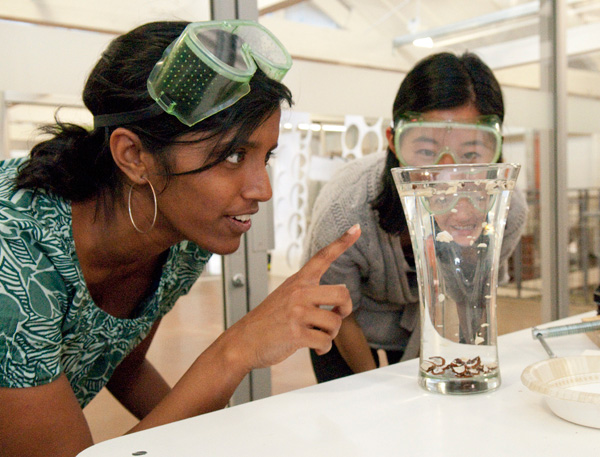A new home for design at Stanford
The newly renovated Building 550, which brings together the Hasso Plattner Institute of Design – better known as the d.school – and the Design Group of the Mechanical Engineering Department, is designed for redesign.
George Kembel, executive director of the Hasso Plattner Institute of Design offers a tour of the new facility for Open Office Hours on Facebook.
After four moves in five years, the Hasso Plattner Institute of Design finally has a home in the newly renovated Building 550. But the institute's culture of innovation and improvement means the inside of the building is designed to be always changing.
"The most important thing we've learned so far about how to design our space is that everything needs to be on wheels," said David Kelley, founder of the institute, commonly known as the "d.school."
The couches, tables, walls – almost everything in the new building – can be moved around.
The building, which opened this spring, brings together students and faculty from Stanford's d.school and the Mechanical Engineering Department's design group to collaborate on innovative projects. On May 7, there will be an official opening event to celebrate their new home.
The d.school, founded in 2005, is a non-degree program that teaches students across the university to use design methodology to tackle problems in their own fields. The school works with about 350 students, whose primary interests range from law to business, education, medicine and engineering.
One initiative housed in the d.school, for example, is the K-12 Laboratory. Started by students from the School of Education and faculty from the d.school in 2006, the group is focused on helping students between kindergarten and college feel more confident in using their creative talents.

Co-term grad student Indu Premakumar and GSB student Joy Sun work on a project to develop a tool for more efficiently processing candle nuts for their 'Design for Extreme Affordability' class.
Daniel Steinbock, a graduate student in education, was one of the founding members of the K-12 Laboratory and has been involved in the d.school since he arrived at Stanford in 2005. He said the most important thing for fostering creative confidence is creating an environment that encourages multiple attempts and failures.
"People acknowledge that mistakes are how you learn, but they don't necessarily create a whole culture and repertoire of collaborative processes that embody and continually reinforce that," he said.
Playing double duty
The d.school has used the spirit of experimentation to make the most of its multiple moves. Since its first space in two white trailers at the edge of campus, the d.school has been housed in Sweet Hall and Building 524.
Rather than separate student workspaces and classrooms, the new d.school home has learned to use the same space for both. Not only is this dual use more efficient in terms of space, but it may foster creativity among the students.
"They don't feel like they are in class anymore, they feel like they are just working," said George Kembel, executive director of the d.school. "The faculty become more like coaches than lecturers."
Each d.school class is taught by a group of faculty members – students never hear just one point of view.
"We nominally have business, technology and human values represented by the faculty on every teaching team," Kelley said. "When you have multiple faculty with different points of view that don't agree with each other, the student has the problem of figuring out what they actually believe."
Opening celebration
The May 7 opening celebration will include a talk by Kembel and tours of the building.
Jess McNally is an intern at the Stanford News Service.

Share This Story